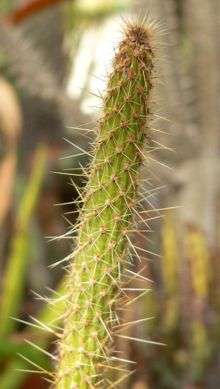Leocereus
| Leocereus bahiensis | |
|---|---|
 | |
| Scientific classification | |
| Kingdom: | Plantae |
| (unranked): | Angiosperms |
| (unranked): | Eudicots |
| (unranked): | Core eudicots |
| Order: | Caryophyllales |
| Family: | Cactaceae |
| Subfamily: | Cactoideae |
| Tribe: | Trichocereeae |
| Genus: | Leocereus Britton & Rose |
| Species: | L. bahiensis |
| Binomial name | |
| Leocereus bahiensis Britton & Rose | |
| Synonyms | |
|
Cereus bahiensis Britton & Rose | |
Leocereus bahiensis is a species of cactus and the only species of the genus Leocereus. Leocereus is a species of cactus that grows in campo rupestre, Brazil, in rocky shady places such as in shrubs or near cliffs and rocks. Leocereus bahiensis are being affected by habitat loss due to range being widespread. The eastern range of the plant generally ends up in an area that is not ideal for agricultural growth. The major threat to habitat loss that happens within numerous national parks (Parque Nacional da Chapada Diamantina, Parque Estadual de Morro Chapeu, Parque Nacional Boqueirão da Onça and Parque Nacional do Rio Parnaiba.) is due to industrialization. The industrial agriculture of soy, Eucalyptus and cotton in the western are of its range are most affected.[1]
The stems of the Leocereus are long, thing and almost terete. They tend to grow like vines, they do not have wool or hairs but the do have needle like spines (about 4cm long, yellowish brown in color) and felt. The flower produced by the Leocereus bahiensis is white and narrow and in the flower are hair bristle spines. A full adult plant can grow up to 2 meters in length and about 1.5 cm in diameter. The areoles are close together and circular. The Leocereus bahiensis hsa fruit 10 to 12 mm with seeds about 1.5 mm long.[2]
It is called in Bahia the tail of the fox due to its long thing bristle like composition. This plant is also one of the few cacti that contain caffeine and mescaline. Mescaline is a psychedelic drug that is produced by some cacti and also called peyote. Leocereus bahiensis was not confirmed part of the Leocereus genus until April 18, 2012[3]
| Wikimedia Commons has media related to Leocereus bahiensis. |
References
- ↑ "Leocereus bahiensis". www.iucnredlist.org. Retrieved 2016-04-27.
- ↑ "Carnegie Science".
- ↑ "Leocereus — The Plant List". www.theplantlist.org. Retrieved 2016-04-27.